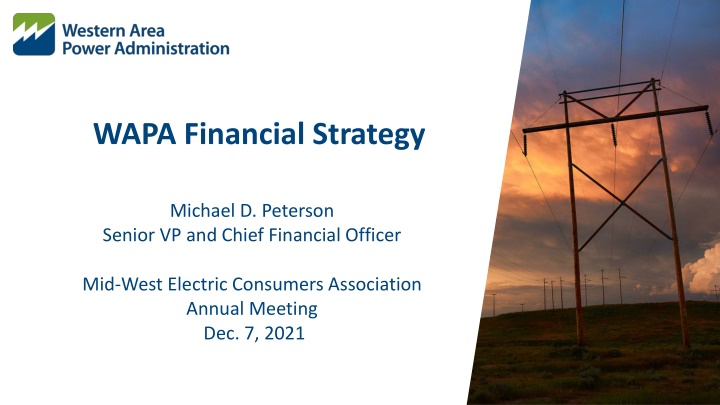Financial Strategy for Reliability and Cost Management in the Electric Power Sector
Strategic considerations for balancing reliability with cost efficiency in the face of challenges like drought, distinguishing between spending and investing, and implementing a consequence ratio to assess asset failure impacts. Updates on financial planning, budgeting, and managing operating costs in a volatile environment are also discussed.
Download Presentation

Please find below an Image/Link to download the presentation.
The content on the website is provided AS IS for your information and personal use only. It may not be sold, licensed, or shared on other websites without obtaining consent from the author.If you encounter any issues during the download, it is possible that the publisher has removed the file from their server.
You are allowed to download the files provided on this website for personal or commercial use, subject to the condition that they are used lawfully. All files are the property of their respective owners.
The content on the website is provided AS IS for your information and personal use only. It may not be sold, licensed, or shared on other websites without obtaining consent from the author.
E N D
Presentation Transcript
WAPA Financial Strategy Michael D. Peterson Senior VP and Chief Financial Officer Mid-West Electric Consumers Association Annual Meeting Dec. 7, 2021
Discussion topics Audience participation is welcome, so please interject Strategic considerations for maintaining reliability while minimizing expenditures Strategic considerations for maintaining reliability while minimizing expenditures Drought = challenges ahead Distinction between spending and investing The Consequence Ratio Finance and budget updates Finance and budget updates FY21 Annual report published, commercial reporting & external audit (KPMG) on track FY22 Year of the continuing resolution? Maybe. FY23 WAPA budget submission approved by DOE, under review by OMB, embargoed FY24 10-year capital plan finalized, development of labor and discretionary budgets underway Managing in an environment of rising prices and volatility Managing in an environment of rising prices and volatility Inflation WAPA s value proposition Purchase Power & Wheeling 2
Drought = challenges ahead Drought conditions projected across all WAPA power systems 3
Distinction between spending and investing Spending consumes value, while Investing creates value ? Transmission Line Substation Helicopter Networking event in Vegas Over-the-top T&E New phones every year Fire extinguishers High voltage signage Security harnesses Outsourced printing Dual monitors Paperclips ? 4
The consequence ratio Probabilistic risk assessment of the negative impact of asset failure Probability of failure (POF) Unique assessment per asset, established by WAPA s Asset Management Team Determined by the health (condition) of a specific asset and its failure history Consequence of loss Relative scoring of the negative impact to customers, the public, and/or WAPA if an asset fails What is considered? Asset failure means the asset is unavailable for service MW impacts are determined with only the asset under evaluation out of service (N-1) 5
The consequence ratio Probabilistic risk assessment of the negative impact of asset failure How is the consequence ratio applied to budgeting for life cycle management assets? The consequence ratio aids in budget prioritization by approximating the inherent risk of run-to-failure results attributable to exceeding LCM targets EXAMPLE: Consider a $100 tire with an LCM target of 50k miles, and a 2:1 Consequence Ratio Cost of running the tire to failure (eg: 75k miles) = $200 (tire + tow) Cost of replacing the tire at 50k miles = $100 (tire) 6
Stages of a budget Formulation, approval and execution Oct Nov Dec Jan Feb Mar Apr May Jun Jul Aug Sep Customers Regional & HQ Capital Planning Discussions Capital Planning FY 2025 WAPA Executive & Legislative Customers 10y Cap Plan Work Plan Presentation Capital Planning Expense Planning FY 2024 WAPA Executive & Legislative Budget Submission to DOE DOE PassbackBudget Submission to OMB Customers FY 2023 WAPA Executive & Legislative OMB Passback President's Budget Congressional Markup CR / Enacted Customers Budget Execution FY 2022 WAPA 1Q Review 2Q Review 3Q Review Executive & Legislative Continuing Resultion / Enacted Budget Customers FY Performance Review Financial Reporting Source Post FY 2021 WAPA FY Performance Review Executive & Legislative 7
Budget formulation & performance strategy FY24 enhancements include peer review, feasibility & rate assessments 10-year plan totals $2B investment (including SLTP) Decrease of $242M from previous plan FY22 13% above previous plan FY24 15% lower than previous plan Rate window Rate window is 3% lower than previous plan Appropriations Assumes levels consistent with FY22 President s Budget 8
Composition of the WAPA 10-Year Capital Plan Transmission lines, substations & communications comprise 83% by Category by Category by Region by Region 9
Inflation Eroding buying power combined with sector-specific pressures merit concern xxx xxx ccc 10
WAPAs value proposition Maintaining reliability & system integrity while holding the line on costs 11
Purchase Power & Wheeling (PPW) Infrastructure Act provides emergency funding to secure FY22 and FY23 Purpose of PPW To firm WAPA s contractual power delivery commitments when the generating assets (federal dams) are unable to provide sufficient power to meet WAPA s contractual obligations. History of PPW Receipt Authority Instituted at WAPA over two decades ago Has always been reimbursable Until four years ago, was scored at net zero 12
Purchase Power & Wheeling (PPW) Infrastructure Act provides emergency funding to secure FY22 and FY23 Infrastructure Investment & Jobs Act Provided $500 million of reimbursable funding for WAPA s PPW reserves to be used exclusively for PPW costs incurred throughout WAPA s footprint This emergency provision addresses WAPA s estimated PPW funding needs through fiscal year-end 2023 13
Purchase Power & Wheeling (PPW) Infrastructure Act provides emergency funding to secure FY22 and FY23 Current PPW Funding Issues Congress has been limiting PPW funding levels since 2018 due to CBO scoring Targeted PPW reserves, established in 2016, total $477 million Re-assessment of PPW reserve targets will commence in 2022, power system by power system At fiscal year-end 21, WAPA s PPW reserves were at 48% of targeted levels ($228 million) WAPA incurred $457 million in PPW costs in FY 2021 14























